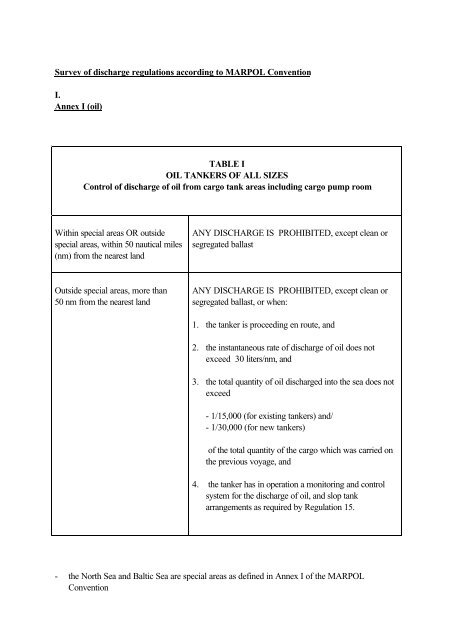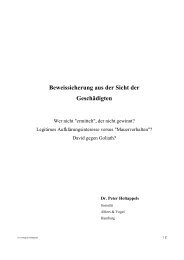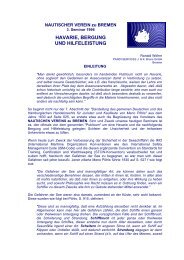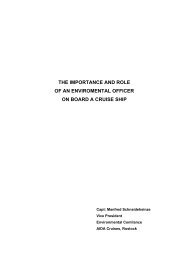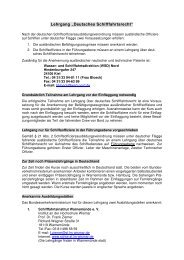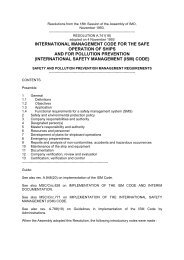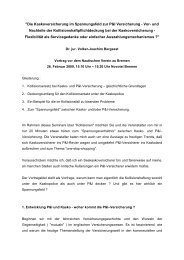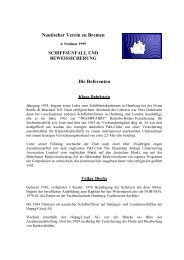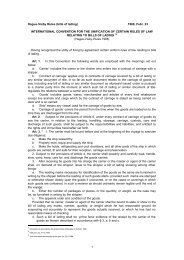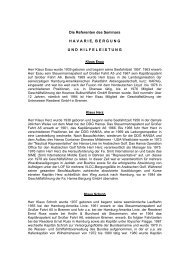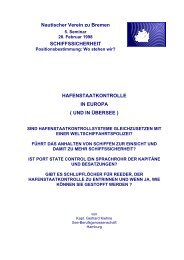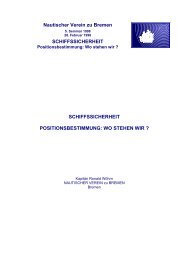Survey of discharge regulations according to MARPOL Convention I ...
Survey of discharge regulations according to MARPOL Convention I ...
Survey of discharge regulations according to MARPOL Convention I ...
Create successful ePaper yourself
Turn your PDF publications into a flip-book with our unique Google optimized e-Paper software.
<strong>Survey</strong> <strong>of</strong> <strong>discharge</strong> <strong>regulations</strong> <strong>according</strong> <strong>to</strong> <strong>MARPOL</strong> <strong>Convention</strong><br />
I.<br />
Annex I (oil)<br />
TABLE I<br />
OIL TANKERS OF ALL SIZES<br />
Control <strong>of</strong> <strong>discharge</strong> <strong>of</strong> oil from cargo tank areas including cargo pump room<br />
Within special areas OR outside<br />
special areas, within 50 nautical miles<br />
(nm) from the nearest land<br />
ANY DISCHARGE IS PROHIBITED, except clean or<br />
segregated ballast<br />
Outside special areas, more than<br />
50 nm from the nearest land<br />
ANY DISCHARGE IS PROHIBITED, except clean or<br />
segregated ballast, or when:<br />
1. the tanker is proceeding en route, and<br />
2. the instantaneous rate <strong>of</strong> <strong>discharge</strong> <strong>of</strong> oil does not<br />
exceed 30 liters/nm, and<br />
3. the <strong>to</strong>tal quantity <strong>of</strong> oil <strong>discharge</strong>d in<strong>to</strong> the sea does not<br />
exceed<br />
- 1/15,000 (for existing tankers) and/<br />
- 1/30,000 (for new tankers)<br />
<strong>of</strong> the <strong>to</strong>tal quantity <strong>of</strong> the cargo which was carried on<br />
the previous voyage, and<br />
4. the tanker has in operation a moni<strong>to</strong>ring and control<br />
system for the <strong>discharge</strong> <strong>of</strong> oil, and slop tank<br />
arrangements as required by Regulation 15.<br />
- the North Sea and Baltic Sea are special areas as defined in Annex I <strong>of</strong> the <strong>MARPOL</strong><br />
<strong>Convention</strong>
TABLE II<br />
OIL TANKERS OF ALL SIZES<br />
OTHER SHIPS OF 400 GRT AND ABOVE<br />
Control <strong>of</strong> <strong>discharge</strong> <strong>of</strong> oil from machinery spaces<br />
Within special areas<br />
ANY DISCHARGE IS PROHIBITED, except when<br />
1. the ship is proceeding en route, and<br />
2. the oil content <strong>of</strong> the effluent without dilution does not exceed<br />
15 ppm, and<br />
3. the ship has in operation oil filtering equipment with au<strong>to</strong>matic<br />
15 ppm s<strong>to</strong>pping device, and<br />
4. bilge water is not mixed with oil cargo residue or cargo pump<br />
room bilges (on oil tankers)<br />
Outside special areas<br />
ANY DISCHARGE IS PROHIBITED, except when<br />
1. the ship is proceeding en route<br />
2. the oil content <strong>of</strong> the effluent is less than 15 ppm*, and<br />
3. the ship has in operation an oil <strong>discharge</strong> moni<strong>to</strong>ring and<br />
control system, oily-water separating or filtering equipment or<br />
other installation required by Regulation 16, and<br />
4. bilge water is not mixed with oil cargo residue or cargo pump<br />
room bilges (on oil tankers)<br />
Note: Oily mixtures which are not mixed with oil cargo residue or<br />
cargo pump room bilges, and where the oil content <strong>of</strong> the effluent<br />
without dilution does not exceed 15 ppm may be <strong>discharge</strong>d<br />
outside special areas without any additional restrictions.
* Until 6 July 1998, less severe <strong>regulations</strong> apply <strong>to</strong> vessels built before July 1993 (an oil content <strong>of</strong><br />
the effluent below 100 ppm is accepted).<br />
TABLE III<br />
SHIPS BELOW 400 GRT OTHER THAN OIL TANKERS<br />
Control <strong>of</strong> <strong>discharge</strong> <strong>of</strong> oil from machinery spaces<br />
Within special areas<br />
ANY DISCHARGE IS PROHIBITED, except when the oil<br />
content without dilution does not exceed 15 ppm<br />
Outside special areas<br />
ANY DISCHARGE IS PROHIBITED, except when the Flag<br />
State considers that all the following conditions are satisfied as far as<br />
practicable and reasonable:<br />
1. the ship is proceeding en route, and<br />
2. the oil content <strong>of</strong> the effluent is less than 15 ppm*, and<br />
3. the ship has in operation suitable equipment as required by<br />
Regulation 16<br />
Note: Oily mixtures where the oil content <strong>of</strong> the effluent without<br />
dilution does not exceed 15 ppm may be <strong>discharge</strong>d without any<br />
additional restrictions.
II.<br />
Annex II (noxious liquid substances in bulk)<br />
1. General<br />
Division <strong>of</strong> noxious substances in<strong>to</strong> 4 categories:<br />
Category<br />
Hazard <strong>to</strong> marine resources or human health<br />
Harm <strong>to</strong> amenities or other<br />
legitimate uses <strong>of</strong> the sea<br />
A Major hazard Serious harm<br />
B Hazard Harm<br />
C Minor hazard Minor harm<br />
D Recognizable hazard Minimal harm
1. Discharge <strong>of</strong> cargo residues<br />
Group<br />
A, B,<br />
and C<br />
In all areas<br />
- ship is proceeding en route<br />
- minimum speed 7 knots (self-propelled) or 4 knots (not self-propelled)<br />
- at least 12 nautical miles from the nearest land<br />
- <strong>discharge</strong> below the waterline<br />
- minimum water depth 25 metres<br />
and outside special areas within special areas<br />
A Maximum concentration <strong>of</strong> tank washings<br />
0.1 percent by weight<br />
Maximum concentration <strong>of</strong> tank washings<br />
0.05 percent by weight<br />
B - per tank max. 1 cubic metre or 1/3,000<br />
<strong>of</strong> the tank capacity in cubic metres<br />
- concentration <strong>of</strong> the substance in the<br />
wake astern <strong>of</strong> the ship max. 1 ppm<br />
C - per tank max. 3 cubic metres or 1/1,000<br />
<strong>of</strong> the tank capacity in cubic metres<br />
- concentration <strong>of</strong> the substance in the<br />
wake astern <strong>of</strong> the ship max. 10 ppm<br />
- the tank has been precleaned, and the<br />
washings have been <strong>discharge</strong>d <strong>to</strong> a<br />
reception facility<br />
- concentration <strong>of</strong> the substance in the<br />
wake astern <strong>of</strong> the ship max. 1 ppm<br />
- per tank max. 1 cubic metre or 1/3,000<br />
<strong>of</strong> the tank capacity in cubic metres<br />
- concentration <strong>of</strong> the substance in the<br />
wake astern <strong>of</strong> the ship max. 1 ppm<br />
D in all areas<br />
- ship is proceeding en route<br />
- minimum speed 7 or 4 knots<br />
- at least 12 nautical miles from the nearest land<br />
- max. one part <strong>of</strong> the substance in ten parts <strong>of</strong> water<br />
1. Special Areas<br />
- Baltic Sea<br />
- Black Sea<br />
- Antarctica
III.<br />
Annex IV (sewage from ships)<br />
1. General<br />
Annex IV has not yet entered in<strong>to</strong> force.<br />
BUT:<br />
in the German terri<strong>to</strong>rial waters, it has largely entered in<strong>to</strong> force on the basis <strong>of</strong><br />
- 8 th Ordinance for the Amendment <strong>of</strong> the Helsinki <strong>Convention</strong> on the Protection <strong>of</strong> the Marine<br />
Environment <strong>of</strong> the Baltic Sea Area<br />
- Ordinance on the Prevention <strong>of</strong> Pollution <strong>of</strong> the North Sea by Sewage from Ships.<br />
1. Discharge <strong>regulations</strong><br />
Sewage<br />
From treatment plants Comminuted and disinfected Untreated<br />
- treatment plant has been<br />
approved by the<br />
Administration<br />
- no visible floating solids or<br />
discoloration <strong>of</strong> surrounding<br />
water<br />
- treatment plant has been<br />
approved by the<br />
Administration<br />
- at least 4 nautical miles from<br />
the nearest land<br />
- retained in holding tanks<br />
- at least 12 nautical miles<br />
from the nearest land<br />
- <strong>discharge</strong> rate approved by<br />
the Administration<br />
- ship is proceeding en route<br />
- minimum speed 4 knots
IV.<br />
Annex V (garbage from ships)<br />
Disposal <strong>of</strong> garbage:<br />
Within special areas Outside special areas<br />
Plastics Other garbage Food wastes Plastics Dunnage, lining<br />
and packing<br />
materials which<br />
will float<br />
Food wastes and<br />
other garbage<br />
Prohibited Prohibited At least 12<br />
nautical miles<br />
from the<br />
nearest land<br />
Prohibited At least 25<br />
nautical miles<br />
from the nearest<br />
land<br />
At least 12<br />
nautical miles<br />
from the nearest<br />
land<br />
But: 3 nautical<br />
miles if passed<br />
through a<br />
comminuter or<br />
grinder<br />
Special areas:<br />
- North Sea<br />
- Baltic Sea<br />
- Mediterranean Sea<br />
- Black Sea<br />
- Red Sea<br />
- Gulfs area<br />
- Antarctica<br />
- Caribbean


